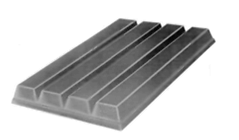Today the European Court of Justice (ECJ, the highest EU court) decided that Nestlé (owner of the KitKat brand), has not shown the below shape has acquired distinctiveness in the European Union, for the purpose of keeping its trade mark registration (see decision here):

This was the fourth appeal in a long saga of cases, which started over 10 years ago. The challenge to Nestlé’s rights is made by Mondelēz (owner of the Cadbury brand).
The law
Shapes, such as the above, are subject to additional scrutiny in order to be registered and stay registered as trade marks. The position of the EU courts is that consumers don’t customarily see product shapes as trade marks (which convey brand significance). Consumers tend to look for a product name, or logo to inform them of the origin of a product.
If a shape trade mark is to be considered valid, it has to prove it has acquired distinctiveness, amongst the relevant public, in the territory where it is registered/registration is sought. For a brand owner to prove a trade mark has acquired distinctiveness, it must provide evidence to show that consumers have learnt, over time and exposure to a product, to recognise that the shape of the product tells them the origin of the goods.
The decision
The key issue in this decision was whether the evidence of acquired distinctiveness had been properly considered by the EUIPO and subsequent appeal bodies.
Nestlé’s shape trade mark covered the whole of the European Union. However, despite some differing of results from different appeal boards, the ECJ agreed with the General Court, that the evidence didn’t show the shape had acquired distinctiveness over the entire EU.
Concerns were raised by on behalf of brand owners, by Nestlé and others, on the potential burden of showing acquired distinctiveness in each EU-Member State. The ECJ’s position was however, focused on the EU-wide nature of an EU trade mark:
- an EU trade mark cannot be valid if it is devoid of distinctive character in any part of the European Union, even just one Member State;
- evidence doesn’t have to be per EU country and may be grouped into regions/be EU-wide; and
- ultimately, evidence must be capable of establishing acquired distinctiveness throughout the Member States of the European Union.
Once this decision is final, it is open to Nestlé to limit its protection to the EU countries where the shape was considered to have acquired distinctiveness.











